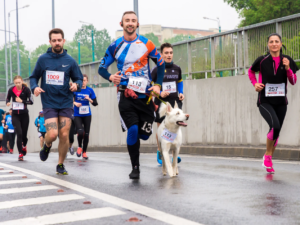
Photo Credit: Unsplash
Walking or running five kilometers (about 3.1 miles) is a great way to get in shape and have fun while doing it. If you’re new to the world of running but ready to dip your toe into race waters, we’ve got you covered. By focusing on a few small steps, you can get to the finish line and sashay your way through your first 5K.
Establish Your Baseline
If you have trouble walking quickly down the sidewalk, getting to the point where you can run more than three miles might seem like a long-off target. But it’s a completely attainable goal with some legwork and planning. Try to start by visualizing yourself at the finish line. Studies show that imagining success helps you attain the vision you steer yourself toward, a sort of helpful self-confirming bias. If you’re a pessimistic over-thinker, there’s still hope for you: Some studies suggest visualizing failure as a way to prepare you for success. Starting positively will help motivate you to push past the negative emotions, but when those negative emotions hit, thinking through failures might also help you incrementally prepare for the tough times when they occur.
Once you can see yourself sweaty, smiling, and proud of your accomplishment (which, when done in real life, can burn roughly 300-400 calories), schedule an appointment with your primary care provider for a health assessment. Just as you would before starting any rigorous exercise regimen, you should get a physical before starting your new running adventure — especially if you haven’t been very active lately.
Eventually, you will want to determine your 1-mile or 1-kilometer pace. However long it takes you to run one mile on your first day will be your baseline pace.
Equipment
Running has few hurdles to get started, at least in the gear department — all you need are shoes and clothes that allow you to move around freely. But there are also some intriguing and potentially useful apps and devices that can amplify your training and race-day experience.
Fitness Trackers
Apps or fitness trackers are completely optional, but they can help you boost your training and performance. Models like the newly-released series 5 Apple Watch connect to apps and consolidate health data, making robust personal health information available at your fingertips so you can refine your training plan to suit your needs.
Most platforms, including Apple Health, are able to track sleep, heart rate, and distance, to name a few features. Other name brands in the running game like Fitbit and Garmin offer a similar but different suite of services for varying prices. Garmin generally has better options for GPS and altitude tracking, while Fitbit is better known for measuring heart rate and step counting.
Shoes
If you’re putting in the miles to train, you should also put in some time to research the shoes that are right for you. To get familiar with the brands, do a little digging online, but plan to visit a running store in-person. Ask for a gait assessment to find custom recommendations for the way that you run. If you like the idea of a fitness tracker, there are a few combination shoes that provide trackers inside the shoes themselves.
Ultimately, a comfortable fit that can take the mileage you need for race day is all you’ll need, but if you invest in running as a long-term commitment, there are plenty of options to suit the budget, ranging from very cheap to very pricey.
Practice Makes Perfect
Establishing a good training plan helps you stay focused on your goal. Joining running clubs with like-minded individuals adds motivation, and usually, a group leader will already have a general training plan to follow.
One training program called Couch to 5K is truly intended to get a beginner from the proverbial couch to running their first 5K. The program takes advantage of the body’s ability to rebuild itself after pushing its thresholds for 20- to 30-minutes three times per week. If this plan seems too easy, you might be ready for fartlek training.
Fartleks are essentially a type of interval training that emphasizes short bursts of speed (sprinting) followed by longer periods of rest, which are then repeated until a certain heart rate goal, time, or distance is met. These exercises enhance speed and shake up endurance training in a way that will definitely have you ready for race day.
Getting started on your first race can feel like quite an undertaking, and it is to some degree, but the exhilaration you feel when you cross the finish line will be well worth all that effort. Who knows? You may be ready to tackle a 10K next!
By: Sheila Olsen
www.fitsheila.com


